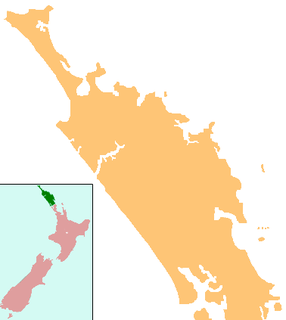Takahiwai is a rural community west of Marsden Bay, in the Whangarei District and Northland Region of New Zealand's North Island. [1]

Marsden Bay is a locality and bay at the south head of Whangarei Harbour in Northland, New Zealand. The western side of Marsden Bay is a coastal community called One Tree Point, and the eastern side is the industrial development of Marsden Point. Ruakaka lies about 9 km to the south.

Whangarei District is a territorial authority district in the Northland Region of New Zealand that is governed by the Whangarei District Council. The district is made up in area largely by rural land, and includes a fifth of the Northland Region. It extends southwards to the southern end of Bream Bay, northwards to Whangaruru and almost to the Bay of Islands, and westwards up the Mangakahia River valley past Pakotai and almost to Waipoua Forest. It includes the Hen and Chicken Islands and the Poor Knights Islands.

The Northland Region is the northernmost of New Zealand's 16 local government regions. New Zealanders often call it the Far North or, because of its mild climate, the Winterless North. The main population centre is the city of Whangarei, and the largest town is Kerikeri.
The Takahiwai Hills, a series of ranges covered in vegetation, dominate the Takahiwai landscape. [1] The ranges include the Takahiwai Forests, one of the largest areas of coastal kanuka [ disambiguation needed ] forest in the world. Kauri-kanuka forest dominates many of the ridges. [2]
Kanuka may refer to:
The area has a local history of Māori settlement by the Patuharakeke people. Pakauhokio, at the western edge of the ranges, was a significant pā site. There is also evidence of pā sites further west along the ridge, and near the harbour coast. [2]
The word pā can refer to any Māori village or defensive settlement, but often refers to hillforts – fortified settlements with palisades and defensive terraces – and also to fortified villages. Pā are mainly in the North Island of New Zealand, north of Lake Taupo. Over 5000 sites have been located, photographed and examined although few have been subject to detailed analysis. No pā have been yet located from the early colonization period when early Polynesian-Māori colonizers lived in the lower South Island. Variations similar to pā are found throughout central Polynesia, in the islands of Fiji, Tonga and the Marquesas Islands.
The local Takahiwai Marae is a meeting place of the Ngātiwai hapū of Te Patuharakeke and the Ngāti Whātua hapū of Patuharakeke. [3] The marae features the Rangiora meeting house. [4]

Ngātiwai or Ngāti Wai is a Māori iwi of the east coast of the Northland Region of New Zealand. Its historical tribal area or rohe stretched from Cape Brett in the north to Takatū Point on Tawharanui Peninsula in the south and out to Great Barrier Island, the Poor Knights Islands and other offshore islands.
In Māoridom and New Zealand, a hapū functions as "the basic political unit within Māori society".

Ngāti Whātua is a Māori iwi (tribe) of the lower Northland Peninsula of New Zealand's North Island. It comprises a confederation of four hapū (subtribes) interconnected both by ancestry and by association over time: Te Uri-o-Hau, Te Roroa, Te Taoū, and Ngāti Whātua-o-Ōrākei. The four hapū can act together or separately as independent tribes.


